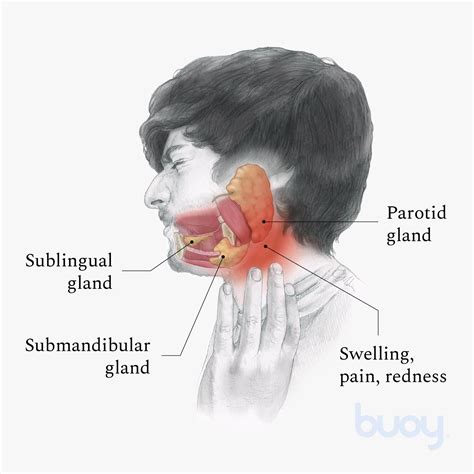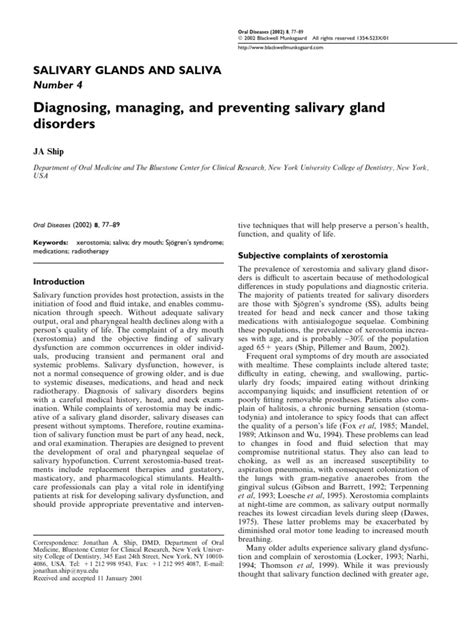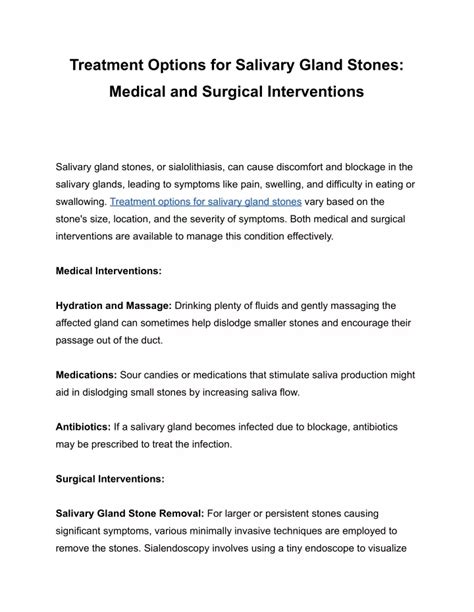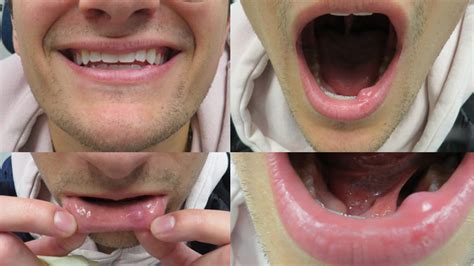Intro
Discover 5 ways to unclog salivary glands, relieving blockages and promoting healthy saliva flow, using natural remedies, dietary changes, and exercises to prevent stones, inflammation, and infection, and maintain optimal oral health and digestion.
The human body has several salivary glands that produce saliva, which plays a crucial role in digestion, mouth lubrication, and overall oral health. However, sometimes these glands can become clogged, leading to discomfort, pain, and difficulty swallowing. Unclogging the salivary gland is essential to restore normal saliva flow and prevent potential complications. In this article, we will explore the importance of salivary glands, the causes of blockages, and most importantly, five ways to unclog salivary glands.
The salivary glands are responsible for producing saliva, which helps break down food, neutralize acids, and wash away bacteria and other pathogens from the mouth. There are three main pairs of salivary glands: the parotid glands, located in front of the ears; the submandibular glands, situated under the jaw; and the sublingual glands, found under the tongue. When these glands become clogged, it can lead to a range of symptoms, including swelling, pain, and difficulty opening the mouth. If left untreated, a clogged salivary gland can lead to infections, abscesses, and even affect overall health.
Clogged salivary glands can be caused by various factors, including salivary stones, tumors, infections, and inflammation. Salivary stones, also known as sialolithiasis, are small, hard deposits that can block the salivary ducts, preventing saliva from flowing out of the gland. Tumors, whether benign or malignant, can also obstruct the salivary ducts, leading to a blockage. Infections, such as sialadenitis, can cause inflammation and swelling, which can clog the salivary gland. Additionally, certain medications, such as antihistamines and decongestants, can reduce saliva production, increasing the risk of blockages.
Understanding Salivary Gland Blockages

5 Ways to Unclog Salivary Glands

1. Stay Hydrated
Drinking plenty of water is essential to help flush out the salivary ducts and prevent blockages. Staying hydrated can help thin out saliva, making it easier to flow through the ducts. Aim to drink at least eight glasses of water a day, and consider increasing your fluid intake if you have a history of salivary gland blockages.
2. Massage the Affected Area
Gentle massage can help stimulate saliva production and encourage the blockage to clear. Use your fingers to massage the affected area in a circular motion, applying gentle pressure. This can help loosen any blockages and promote saliva flow.
3. Apply Warm Compresses
Applying a warm compress to the affected area can help reduce swelling and promote saliva production. Soak a cloth in warm water, wring it out, and apply it to the area for 5-10 minutes. Repeat this process several times a day to help loosen the blockage.
4. Try Salivary Gland Stimulants
Certain foods and substances can help stimulate saliva production and promote saliva flow. Try sucking on lemons or limes, or drinking lemonade to stimulate saliva production. You can also try chewing sugar-free gum or eating sour candies to stimulate saliva flow.
5. Seek Medical Attention
If home remedies do not work, or if the blockage persists, it is essential to seek medical attention. A healthcare professional or dentist can diagnose the underlying cause of the blockage and recommend treatment options, such as antibiotics, pain relief medication, or surgical removal of the blockage.
Preventing Salivary Gland Blockages

- Practice good oral hygiene, including regular brushing and flossing
- Avoid smoking and tobacco products, which can reduce saliva production
- Limit consumption of sugary and acidic foods and drinks
- Stay hydrated and drink plenty of water
- Avoid using straws, which can reduce saliva production
Treatment Options for Salivary Gland Blockages

- Antibiotics to treat infections
- Pain relief medication to manage symptoms
- Surgical removal of the blockage
- Salivary gland stimulation to promote saliva production
Complications of Untreated Salivary Gland Blockages

- Infections, such as sialadenitis
- Abscesses, which can lead to serious health complications
- Tumors, which can be benign or malignant
- Reduced saliva production, which can lead to dry mouth and oral health problems
Conclusion and Next Steps

We invite you to share your experiences and ask questions about salivary gland blockages in the comments section below. Your feedback is valuable to us, and we will do our best to respond to your queries. If you found this article helpful, please share it with your friends and family to help raise awareness about the importance of salivary gland health.
What are the symptoms of a salivary gland blockage?
+The symptoms of a salivary gland blockage include swelling, pain, and difficulty opening the mouth. You may also experience dry mouth, bad breath, and difficulty swallowing.
How can I prevent salivary gland blockages?
+To prevent salivary gland blockages, practice good oral hygiene, stay hydrated, and avoid sugary and acidic foods and drinks. You should also avoid using straws and limit your consumption of tobacco products.
What are the treatment options for salivary gland blockages?
+The treatment options for salivary gland blockages include antibiotics, pain relief medication, and surgical removal of the blockage. Your healthcare professional or dentist may also recommend salivary gland stimulation to promote saliva production.
